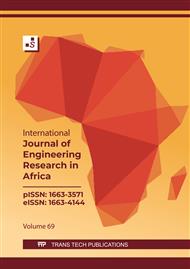[1]
A. Graf, Aluminum alloys for lightweight automotive structures, in: P.K.B.T.-M. Mallick Design and Manufacturing for Lightweight Vehicles (Second Edition) (Ed.), Woodhead Publ. Mater., 2021, p.97–123.
DOI: 10.1016/b978-0-12-818712-8.00003-3
Google Scholar
[2]
A.A. Luo, Recent advances in light metals and manufacturing for automotive applications, CIM J. 12 (2021) 79–87.
DOI: 10.1080/19236026.2021.1947088
Google Scholar
[3]
A. Mahata, M. Asle, Evolution of solidi fi cation defects in deformation of nano-polycrystalline aluminum, Comput. Mater. Sci. 163 (2019) 176–185.
DOI: 10.1016/j.commatsci.2019.03.034
Google Scholar
[4]
D. C. Rapaport, The Art of Molecular Dynamics Simulation, second edi, 2004.
Google Scholar
[5]
M. P. Allen & D. J. Tildesley, Computer Simulation of Liquids, New Tork, 1987.
Google Scholar
[6]
M.R.P. P. Dea, T. Frauenheim, Computer Simulation of Materials at Atomic Level, First edit, Berlin, 2000.
Google Scholar
[7]
H. Chabba, M. Taoufiki, A. Barroug, A. Jouaiti, D. Dafir, Atomistic nanoindentation study of Al–Mg intermetallic compounds based on molecular dynamics simulation, Int. J. Comput. Mater. Sci. Eng. 11 (2022) 2250011.
DOI: 10.1142/s2047684122500117
Google Scholar
[8]
B.S. D. Frenkel, Understanding molecular dynamics simulation from algorithms to applications, Second edi, London, 1996.
Google Scholar
[9]
D. Dengpan, Z. Weiwei, B. Adam, J. Lu, A.C.T. Van Duin, V. Molinero, D. Bedrov, Multiscale Modeling of Structure , Transport and Reactivity in Alkaline Fuel Cell Membranes : Molecular Dynamics Simulations, (2018) 14.
DOI: 10.3390/polym10111289
Google Scholar
[10]
M. Taoufiki, H. Chabba, D. Dafir, A. Barroug, M. Boulghallat, A. Jouaiti, Atomistic Investigation Using Molecular Dynamics Simulation of τ4-Al3FeSi2 and τ12-Al3Fe2Si Phases under Tensile Deformation, Int. J. Eng. Res. Africa. 61 (2022) 1–15.
DOI: 10.4028/p-0xoa4x
Google Scholar
[11]
M.A. Cooper, M.S. Oliver, D.C. Bufford, B.C. White, J.B. Lechman, Compression behavior of microcrystalline cellulose spheres : Single particle compression and con fi ned bulk compression across regimes, Powder Technol. 374 (2020) 10–21.
DOI: 10.1016/j.powtec.2020.06.089
Google Scholar
[12]
T. Benitez, J. Sandro, R. Murillo, D. De Ligny, N. Travitzky, A. Pedro, N. De Oliveira, D. Hotza, Modeling the e ff ect of the addition of alumina on structural characteristics and tensile deformation response of aluminosilicate glasses, Ceram. Int. 46 (2020) 21657–21666.
DOI: 10.1016/j.ceramint.2020.05.273
Google Scholar
[13]
J.-P.A.I. and W.W. A. S. Krausz, J. I. Dickson, constitutive laws of plastic deformation and fracture, 19th ed., KLUWER ACADEMIC PUBLISHERS, Ottawa, 1989.
Google Scholar
[14]
T.B. Massalski, Massalski T.B. Binary alloy phase diagrams. V2, (1986) 1129.
Google Scholar
[15]
S.M. Foiles, M.I. Baskes, M.S. Daw, Embedded-atom-method functions for the fcc metals Cu, Ag, Au, Ni, Pd, Pt, and their alloys, Phys. Rev. B. 33 (1986) 7983–7991.
DOI: 10.1103/physrevb.33.7983
Google Scholar
[16]
M.S. Daw, M.I. Baskes, Embedded-atom method: Derivation and application to impurities, surfaces, and other defects in metals, Phys. Rev. B. 29 (1984) 6443–6453.
DOI: 10.1103/physrevb.29.6443
Google Scholar
[17]
P. GANSTER, Modelling of nuclear glasses by classical and ab initio molecular dynamics, MONPELLIER II, 2005.
Google Scholar
[18]
M.I. Baskes, Modified embedded-atom potentials for cubic materials and impurities, Phys. Rev. B. 46 (1992) 2727–2742.
DOI: 10.1103/physrevb.46.2727
Google Scholar
[19]
M.I. Baskes, Modified embedded-atom potentials for cubic materials and impurities, Phys. Rev. B. 46 (1992) 2727–2742.
DOI: 10.1103/PhysRevB.46.2727
Google Scholar
[20]
K. Ji, C. Arson, Tensile strength of calcite/HMWM and silica/HMWM interfaces: A Molecular Dynamics analysis, Constr. Build. Mater. 251 (2020).
DOI: 10.1016/j.conbuildmat.2020.118925
Google Scholar
[21]
L. Verlet, Computer "experiments" on classical fluids. II. Equilibrium correlation functions, Phys. Rev. 165 (1968) 201–214.
DOI: 10.1103/PhysRev.165.201
Google Scholar
[22]
C. Braga, K.P. Travis, A configurational temperature Nosé-Hoover thermostat, J. Chem. Phys. 123 (2005) 0–15.
DOI: 10.1063/1.2013227
Google Scholar
[23]
X.X. Zhang, H. Andrä, S. Harjo, W. Gong, T. Kawasaki, A. Lutz, M. Lahres, Quantifying internal strains, stresses, and dislocation density in additively manufactured AlSi10Mg during loading-unloading-reloading deformation, Mater. Des. 198 (2021) 1–9.
DOI: 10.1016/j.matdes.2020.109339
Google Scholar
[24]
J. Guénolé, W.G. Nöhring, A. Vaid, F. Houllé, Z. Xie, A. Prakash, E. Bitzek, Assessment and optimization of the fast inertial relaxation engine (FIRE) for energy minimization in atomistic simulations and its implementation in LAMMPS, Comput. Mater. Sci. 175 (2020) 109584.
DOI: 10.1016/j.commatsci.2020.109584
Google Scholar
[25]
Y. Wang, J. Zuo, N. Jiang, K. Niu, Y. Wu, Uniaxial tension deformation study of copper/nickel laminated composites: Effects of lamella number and interlamellar spacing, Comput. Mater. Sci. 171 (2020) 109272.
DOI: 10.1016/j.commatsci.2019.109272
Google Scholar
[26]
S. Plimpton, Fast Parallel Algorithms for Short-Range Molecular Dynamics, J. Comput. Phys. 17 (1995) 1–19.
DOI: 10.1039/c7sm02429k
Google Scholar
[27]
A. Stukowski, Visualization and analysis of atomistic simulation data with OVITO–the Open Visualization Tool, Model. Simul. Mater. Sci. Eng. 18 (2010) 15012.
DOI: 10.1088/0965-0393/18/1/015012
Google Scholar
[28]
K. Momma, F. Izumi, VESTA 3 for three-dimensional visualization of crystal, volumetric and morphology data, J. Appl. Crystallogr. 44 (2011) 1272–1276.
DOI: 10.1107/S0021889811038970
Google Scholar
[29]
A. Stukowski, Visualization and analysis of atomistic simulation data with OVITO–the Open Visualization Tool, Model. Simul. Mater. Sci. Eng. 18 (2009) 15012.
DOI: 10.1088/0965-0393/18/1/015012
Google Scholar
[30]
P.R. Matli, F. Ubaid, R.A. Shakoor, G. Parande, V. Manakari, M. Yusuf, A.M. Amer Mohamed, M. Gupta, Improved properties of Al-Si3N4 nanocomposites fabricated through a microwave sintering and hot extrusion process, RSC Adv. 7 (2017) 34401–34410.
DOI: 10.1039/c7ra04148a
Google Scholar
[31]
M.A. Haque, M.T. A Saif, Mechanical behavior of 30-50 nm thick aluminum films under uniaxial tension, Scr. Mater. 47 (2002) 863–867.
DOI: 10.1016/S1359-6462(02)00306-8
Google Scholar
[32]
Q. Zeng, L. Wang, W. Jiang, Molecular dynamics simulations of the tensile mechanical responses of selective laser-melted aluminum with different crystalline forms, Crystals. 11 (2021).
DOI: 10.3390/cryst11111388
Google Scholar
[33]
M.E. Suk, Effect of the nanotube radius and the volume fraction on the mechanical properties of carbon nanotube-reinforced aluminum metal matrix composites, Molecules. 26 (2021).
DOI: 10.3390/molecules26133947
Google Scholar
[34]
M. Taoufiki, H. Chabba, A. Barroug, A. Jouaiti, D. Dafir, Atomic-scale compression and tensile investigations for crystalline Aluminum using EAM and MEAM potentials, Moroccan J. Chem. 10 (2022) 362–374.
Google Scholar
[35]
H. Chabba, M. Lemaalem, A. Derouiche, D. Dafir, Modeling aluminum using molecular dynamics simulation, J. Mater. Environ. Sci. 9 (2018) 93–99.
DOI: 10.26872/jmes.2018.9.1.11
Google Scholar


